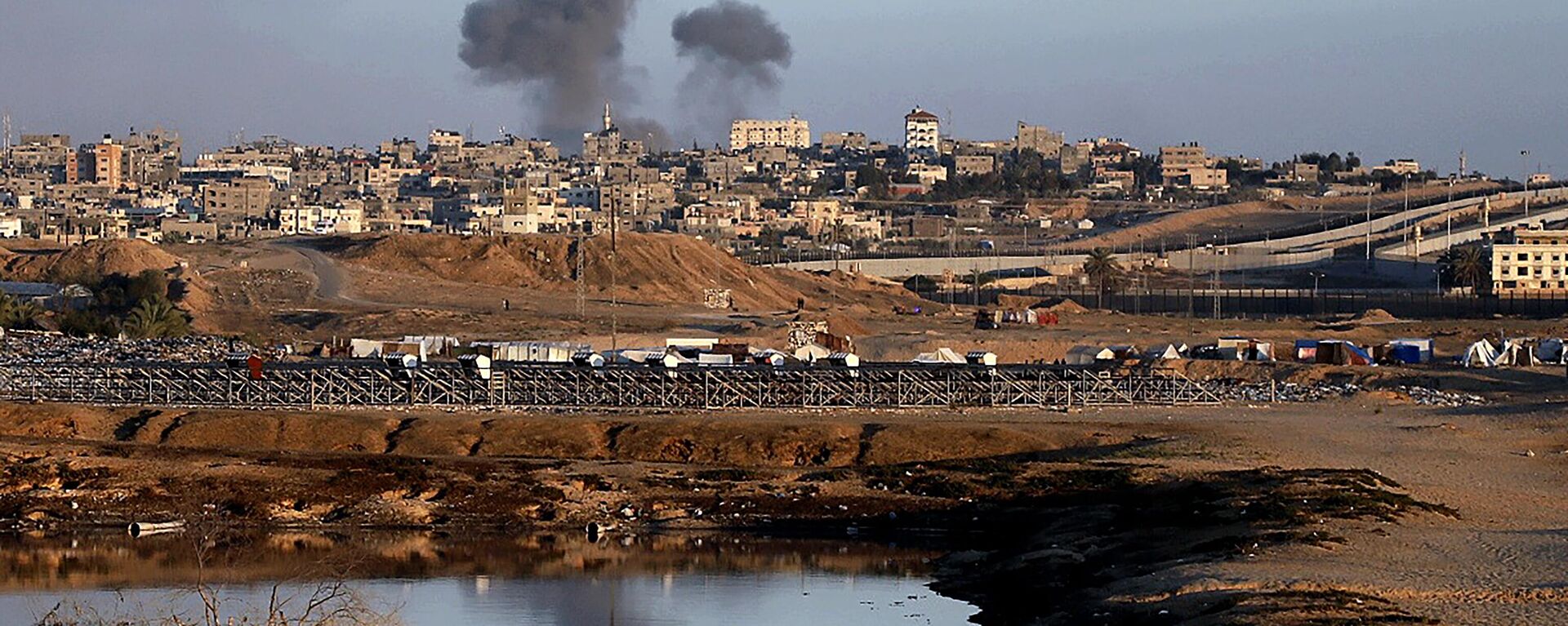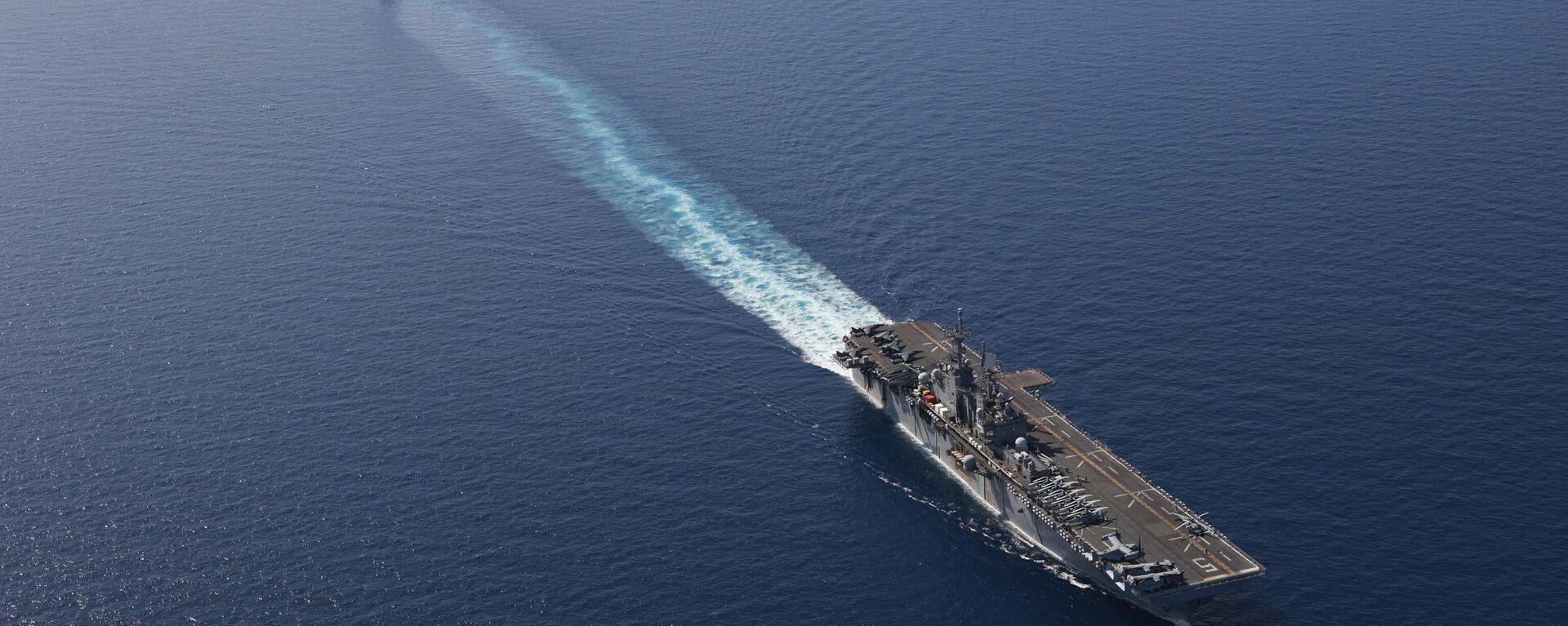https://sputnikglobe.com/20240514/us-destroyer-quits-red-sea-sails-home-as-houthis-warn-of-escalation-enemy-cant-imagine-1118423160.html
US Destroyer Quits Red Sea, Sails Home as Houthis Warn of Escalation Enemy ‘Can’t Imagine’
US Destroyer Quits Red Sea, Sails Home as Houthis Warn of Escalation Enemy ‘Can’t Imagine’
Sputnik International
The Yemeni militia’s unrelenting campaign of ship hijackings and missile and drone attacks targeting Israeli, US and UK-linked commercial vessels has resulted in a two-thirds drop in traffic through the strategic Red Sea chokepoint since December. The militia has vowed to end its campaign if Israel halts its military incursion into Gaza.
2024-05-14T10:55+0000
2024-05-14T10:55+0000
2024-05-14T11:21+0000
world
red sea
israel
lisa franchetti
houthi
navy
uss carney
red sea crisis
https://cdn1.img.sputnikglobe.com/img/07e8/05/0e/1118423001_0:133:1751:1117_1920x0_80_0_0_84a2380ab805c3e5ad78014d411c4dbc.jpg
The USS Carney destroyer – the warship which became the face of the US Navy’s anti-Houthi operations last fall, left the Red Sea and arrived in Norfolk, Virginia after a grueling, months-long deployment in the Middle East.The Arleigh Burke-class guided-missile destroyer was deployed for "routine operations" with the US 5th and 6th Fleets in late September 2023, but quickly found itself in the center of a hornet’s nest of escalating Middle East tensions in October after Hamas' surprise attack on Israel, and the subsequent Israeli aerial bombardment and ground invasion of Gaza.The warship escorted commercial vessels in an attempt to shield them from Houthi strikes, and itself became targeted repeatedly by drones and missiles. Beginning in January, the destroyer began firing its cruise missiles at targets inside Yemen in a desperate bid to weaken the Houthis’ strike potential.“I could not be more proud of what the Carney team has done since September,” US Chief of Naval Operations Admiral Lisa Franchetti said at a ceremony welcoming the warship to Norfolk. “Called to action on the very first day that you entered the US 5th Fleet, you conducted 51 engagements in 6 months,” the admiral said.The USS Carney is the latest warship from two separate Western coalitions – the US-UK-led Operation Prosperity Guardian and the EU’s Operation Aspides, to leave the Red Sea and head home. Last month, German Navy frigate the Hessen left the area and sailed back to Germany as Houthi leader Abdul Malik al-Houthi promised European countries safe passage if they were "not heading towards the Israeli enemy.” The EU-led operation has been far less belligerent than its US and UK-led counterpart so far, with EU warships not attacking targets inside Yemen.Senate Armed Services Subcommittee on Strategic Forces Chairman Angus King warned at a hearing last week that US missile defenses have proven exorbitantly costly and ineffective not only against strategic adversaries like Russia, China, and Iran, but even against the Houthis, whose ability to churn out cheap missiles and drones are contrasted by the price tag of the American missile interceptors designed to stop them.Unimaginable EscalationHouthi military spokesman Yahya Sare’e warned at a press conference on Monday that the militia would escalate its campaign to a level the enemy can’t even imaginable if Israel and its allies continue to cross Yemen’s “red lines.”“Gaza is a red line for us, a red line. Our causes, holy sites, and our Islam are red lines, and we will not compromise on them,” Sare’e said.Sare’e did not elaborate on what these hitherto "unimaginable" strikes may entail. However, earlier this month, the official announced the start of a “fourth phase” of Houthi operations against Israel, including the targeting of all ships heading to Israel’s Mediterranean Sea ports from “any area within our reach.”Last week, the Center for International Maritime Security, a Maryland-based security affairs think tank, admitted that Western naval operations in the Red Sea have been “hampered by various shortcomings,” including “ammunition shortages, a lack of coordination between allied nations, as well as deficient equipment.”Comparing the timing of the US and European-led anti-Houthi operations against the backdrop of declining maritime traffic through the Bab el Mandeb strait, the think tank admitted that “so far, military operations have not led to a recovery in maritime traffic levels” through the region.
https://sputnikglobe.com/20240513/russian-un-envoy-says-israeli-operation-in-rafah-will-have-negative-impact-on-red-sea-1118414095.html
https://sputnikglobe.com/20240512/us-military-shoots-down-3-houthi-drones-over-red-sea-1118392814.html
https://sputnikglobe.com/20240508/houthis-vow-to-target-all-israel-linked-ships-in-reach-as-think-tank-warns-of-naval-drone-threat-1118340965.html
https://sputnikglobe.com/20240430/houthis-launch-missile-and-drone-rampage-targeting-four-ships-after-rejecting-us-bribe-attempt-1118196502.html
red sea
israel
Sputnik International
feedback@sputniknews.com
+74956456601
MIA „Rosiya Segodnya“
2024
News
en_EN
Sputnik International
feedback@sputniknews.com
+74956456601
MIA „Rosiya Segodnya“
Sputnik International
feedback@sputniknews.com
+74956456601
MIA „Rosiya Segodnya“
can the houthis be stopped, why can't houthis be stopped
can the houthis be stopped, why can't houthis be stopped
US Destroyer Quits Red Sea, Sails Home as Houthis Warn of Escalation Enemy ‘Can’t Imagine’
10:55 GMT 14.05.2024 (Updated: 11:21 GMT 14.05.2024) The Yemeni militia’s unrelenting campaign of ship hijackings and missile and drone attacks targeting Israel, US, and UK-linked commercial vessels has resulted in a two-thirds drop in traffic through the strategic Red Sea chokepoint since December. The militia has vowed to end its campaign if Israel halts its military incursion into Gaza.
The USS Carney destroyer – the warship which became the face of the US Navy’s anti-Houthi operations last fall, left the Red Sea and arrived in Norfolk, Virginia after a grueling, months-long deployment in the Middle East.
The Arleigh Burke-class guided-missile destroyer was deployed for "routine operations" with the US 5th and 6th Fleets in late September 2023, but quickly found itself in the center of a hornet’s nest of escalating Middle East tensions in October after Hamas' surprise attack on Israel, and the subsequent Israeli aerial bombardment and ground invasion of Gaza.
The USS Carney became the first US warship to engage Houthi drones and missiles, with the Yemeni militia attempting to strike Israel starting on October 19, and the American warship deployed to shield Tel Aviv. The militia switched tactics in November, setting up a semi-blockade of the Red and Arabian Seas, unilaterally closing the bodies of water to all vessels with suspected "Israeli links."
The warship escorted commercial vessels in an attempt to shield them from Houthi strikes, and itself became targeted repeatedly by drones and missiles. Beginning in January, the destroyer began firing its cruise missiles at targets inside Yemen in a desperate bid to weaken the Houthis’ strike potential.
“I could not be more proud of what the Carney team has done since September,” US Chief of Naval Operations Admiral Lisa Franchetti
said at a ceremony welcoming the warship to Norfolk. “Called to action on the very first day that you entered the US 5th Fleet, you conducted 51 engagements in 6 months,” the admiral said.
The Navy did not elaborate on when exactly the Carney left the Red Sea before beginning the long trek across the Atlantic. After resupply in Norfolk, the warship is expected to sail to its home base at Naval Station Mayport outside Jacksonville, Florida.
The USS Carney is the latest warship from two separate Western coalitions – the US-UK-led Operation Prosperity Guardian and the EU’s Operation Aspides, to leave the Red Sea and head home. Last month, German Navy frigate the Hessen left the area and
sailed back to Germany as Houthi leader Abdul Malik al-Houthi promised European countries safe passage if they were "not heading towards the Israeli enemy.” The EU-led operation has been far less belligerent than its US and UK-led counterpart so far, with EU warships not attacking targets inside Yemen.
Senate Armed Services Subcommittee on Strategic Forces Chairman Angus King warned at a hearing last week that US missile defenses have proven exorbitantly costly and ineffective not only against strategic adversaries like Russia, China, and Iran, but even against the Houthis, whose ability to churn out cheap missiles and drones are contrasted by the price tag of the American missile interceptors designed to stop them.
“One missile to intercept an incoming [strategic] missile is $80 million,” King told gathered DoD officials. “Well in the Red Sea, the Houthis are sending $20,000 drones and we’re shooting them down with missiles that cost $4.3 million. The math doesn’t work on that, gentlemen. It just doesn’t work. What are we thinking?” King, an advocate of directed energy weapon-based defenses, asked.
Houthi military spokesman Yahya Sare’e warned at a press conference on Monday that the militia would escalate its campaign to a level the enemy can’t even imaginable if Israel and its allies continue to cross Yemen’s “red lines.”
“Gaza is a red line for us, a red line. Our causes, holy sites, and our Islam are red lines, and we will not compromise on them,” Sare’e said.
“We can target things that the enemy hasn’t thought of and can’t imagine, things that neither the Yemeni people nor the people of the [Arab and Muslim World] can imagine,” he
warned. “By God’s will and strength, we will reach the fifth and sixth stages [of anti-Israeli operations, ed.] if the enemy continues its aggression on Gaza.”
Sare’e did not elaborate on what these hitherto "unimaginable" strikes may entail. However, earlier this month, the official announced the start of a “fourth phase” of Houthi operations against Israel, including the targeting of all ships heading to Israel’s Mediterranean Sea ports from “any area within our reach.”
Last week, the Center for International Maritime Security, a Maryland-based security affairs think tank,
admitted that Western naval operations in the Red Sea have been “hampered by various shortcomings,” including “ammunition shortages, a lack of coordination between allied nations, as well as deficient equipment.”
“It is questionable at best whether the current naval operations can become a success on the strategic level,” the think tank said, noting that the military effort has been “characterized by complicated coordination on the political level, virtually non-existent broader engagement with Houthi leaders, as well as a lack of clearly identified – and achievable – aims.”
Comparing the timing of the US and European-led anti-Houthi operations against the backdrop of declining maritime traffic through the Bab el Mandeb strait, the think tank admitted that “so far, military operations have not led to a recovery in maritime traffic levels” through the region.








